UDIM is a enhancement to the UV mapping and texturing workflow that makes UV map generation easier and assigning textures simpler. At its core, UDIM is simply an automatic UV offset system that assigns an image onto a specific UV tile, that allows artists to use multiple lower resolution texture maps for neighboring surfaces, producing a higher resolution result without having to resort to using a single, ultra high-resolution image. In order to understand the benefits of the UDIM workflow, its best to have a basic understanding of how UV mapping works.
UV Mapping Basics
UV mapping is the translation of a three-dimensional surface into the two-dimensional coordinate system of flat bitmap images (or vice-versa depending on how you look at it). Each vertex of the originating surface is given a coordinate on the UV map and the pixel values in-between are interpolated across the flat polygon surface for highly accurate texturing control (with the 'U' and 'V' axes names chosen specifically as to not cause confusion with the X,Y and Z axes for the actual model). The UV map coordinate values are organized into a grid system where the image itself appears in the 0-1 area of the grid and the area outside of this tile simply repeats the image outward. Because of this fact, traditionally only the UV 0-1 space was ever really used (well, outside of controlling how a surface tiled an image).
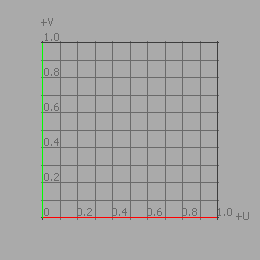
UDIM Basics
With a UDIM workflow, each whole tile section, 0-1, 1-2, 2-3 and so on, can have its own independent image map assigned to it, all within the same surface. Each image can have its own resolution as well. The UDIM workflow is simply a notation format that names images accordingly so they are automatically assigned to a specific UV tile. The numbering starts at the UV origin and moves in the positive direction outward ten tiles (to 1010) and then repeats the rows stacked on top of each other moving upward 9999 rows. This illustration demonstrates a small section of the overall UDIM tile area as it relates to the UV space (the upper image corresponding to the lower left corner of this one).
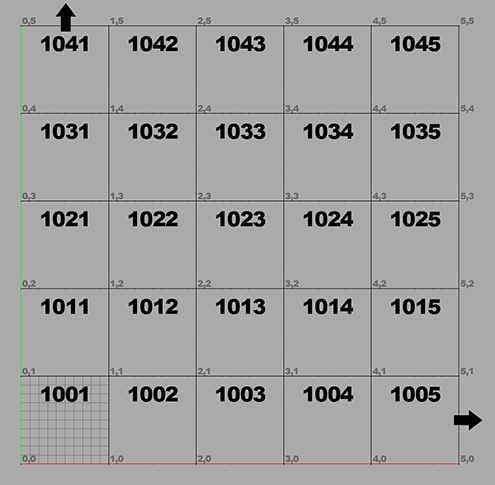
Mapping Your Model
Using a UDIM workflow begins with the UV mapping of the actual geometry. Decisions are made at this stage as to how the model will be divided, typically based on what degree of resolution is required for the project. For an average character project, the tiles *could* be broken up into the head in one tile, the front of the body on another and the back on another still. Higher resolution requirements might necessitate having hands and/or feet on separate tiles as well. For information on MODO's UV mapping tools, please reference the UV mapping page of the documentation, or the UV tools reference page.
For individual parts it will likely be easiest to create and adjust the initial UV map for a given section in the UV 0-1 tile as many tools default to this locale. Once the map is laid out as desired, it can be moved with the Transform tool ('W' key shortcut)to the desired UDIM tile. When working in the 'UV Edit' interface layout it is easiest to simply enter whole number UV values to offset to a specific location, for example U 4.0 and V 3.0 for UDIM 1035, though it will be most economical to keep the tiles consecutively placed, but never spanning more than ten tiles in any horizontal row.
Assigning the UDIMs Automatically
Once the model is prepared with the UV map, its time to start texturing. Multiple UDIMs can be imported from an external painting app (such as MARI) or created from scratch in modo. This is achieved by first creating a 'New Image Folder' in the 'Images' tab (typically found in the same viewport group as the 'Shader' viewport). LMB+click the 'Add Clip' button and choose the 'New Image Folder' option.
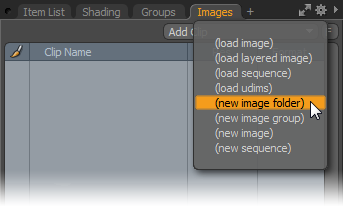
This action creates a folder in the 'Images' viewport. With this folder selected, use the 'Load Images' option and import multiple images from a single location, or singly import images from multiple locations. Additionally, using the 'New Image' option, blank image maps can be created, but will need to be manually named according to its related UDIM tile location(!). Make sure to adhere to a proper naming convention, typically <filename>.<UDIM value).<format extension>; so, for example, a proper name might be "hero_wings_diffuse.1012.EXR". Images in the 'Images' viewport that aren't under the image group Folder can be simply drag and dropped onto the folder. Also feel free to rename the folder to something else more suitable, if desired.
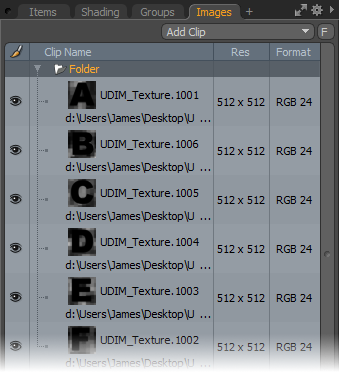
The next step is to assign the proper UDIM values to each bitmap image. This can be done in one go by selecting all the images within the folder (LMB+click the top most image to select and then Shift+LMB+click the bottom most layer, selecting all layer in-between). Under the 'Image Still' subtab (in the Properties' viewport panel) LMB+click the 'Set UDIM from Filename' button to assign the values automatically. Now the Folder is ready to be applied to a surface.
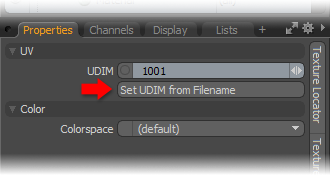
All the images in the 'Folder' created in the previous steps can be assigned to a surface in the 'Shader Tree' at once. Using the 'Add layer' button, select the "Image Map -> Use Clip Browser' option. When the Clip Browser opens, select the 'Folder' created in the previous step and it will appear as a single layer in the Shader Tree. This layer can be treated like a regular texture layer. Please reference the Add Image page of the documentation for information about adding and using texture maps and the Shader Tree page for information on working with Shader Tree layers. If you're textures aren't showing up, it may be necessary to check that the correct UV map is specified in the associated 'Texture Locator' (and for older models it may be necessary to make sure the 'Use Clip UDIM' option is enabled as well). Once assigned with the proper 'Effect' type, it is ready for Rendering, or if this is the beginning of the process, then it is ready for texture painting or baking.
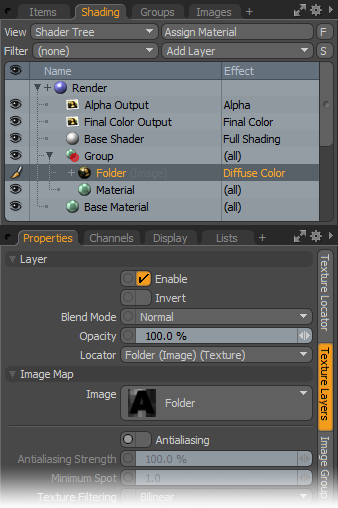
TIP: Each 'Folder's assigned this way to the Shader Tree can only have a single layer 'Effect', such as 'Diffuse Color' or 'Bump'. Individual Images within a folder can't have their own unique 'Effect' setting, so its important to make sure that the images are arranged into their own folders for each 'Effect' type applied to the surface.
MARI Workflow
MODO's UDIM automation options really shine when working with an external texturing application, such as The Foundry's 'MARI' where image map UDIM naming is automatic. When working on complex models where there are possibly hundreds of images associated with it, this is definitely the way to go as MARI will save the images directly and then MODO will import entire folders of images and assign the UDIM offset values automatically based on the file names from MARI.
When working with MARI specifically, make sure the 'Preferences' option for UDIMs under the "Defaults - Images and Painting" is set as 'last four digit number in filename'. This ensures that the filename UDIMs will be read properly when imported.

Loading of an entire folder of images saved in MARI into an 'Image Folder' in MODO and setting the UDIM values for each image is done in one operation. In the 'Images' viewport panel, select the 'Load UDIMs' option.
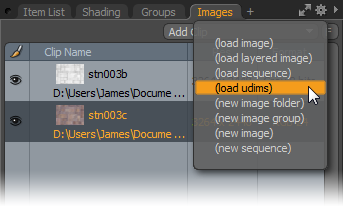
This opens an OS specific dialog where users can navigate to any folder of UDIM images and multi-select all the associated images and press the 'Open' button. This loads the images into a image group 'Folder' and specifies the UDIM value for each automatically. The image can now be assigned in the Shader Tree like any other texture layer.


